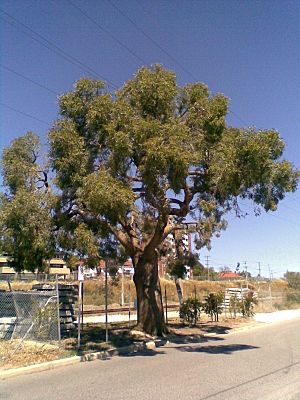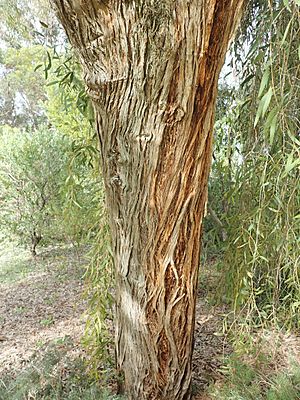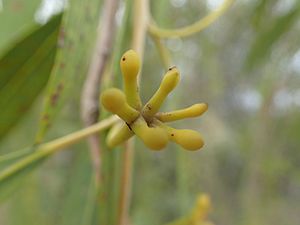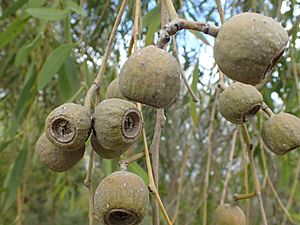Coastal blackbutt facts for kids
The Coastal Blackbutt (scientific name: Eucalyptus todtiana) is a special type of tree or a shrub-like plant called a mallee. It grows only along the west coast of Western Australia. People also call it the Pricklybark or by its Indigenous name, dwutta. This plant has rough, flaky bark on its main trunk. Its branches have smooth bark. It also has long, thin leaves, white flowers, and fruit shaped like a cup.
Quick facts for kids Coastal blackbutt |
|
|---|---|
 |
|
| A remnant coastal blackbutt in Victoria Park, Western Australia | |
| Scientific classification | |
| Genus: |
Eucalyptus
|
| Species: |
todtiana
|
Contents
What Does It Look Like?
The Coastal Blackbutt can grow as a tree or a mallee. It usually reaches a height of 2 to 15 meters (about 6 to 49 feet). This plant has a special woody swelling at its base called a lignotuber. This helps it regrow after fires.
Its bark is rough and prickly on the lower trunk. The upper trunk has scaly bark. The branches have smooth bark that can be grey or pinkish. The tree often has a "weeping" look. Its branches hang down.
Leaves and Flowers
Young Coastal Blackbutt plants have oval-shaped leaves. These leaves are about 5.5 to 13 cm (2 to 5 inches) long. They grow in pairs. Adult leaves are light green and shaped like a spear. They are about 8 to 12.5 cm (3 to 5 inches) long. These leaves grow one after another along the stem. The tree has a thick, spreading crown of leaves.
Its flower buds grow in groups of seven, nine, or eleven. They are found where the leaves meet the stem. Each bud is oval-shaped. They are about 8 to 11 mm long. The flowers are creamy white. They usually bloom from January to April.
Fruit
After flowering, the plant produces woody fruits. These fruits are shaped like a cup or half a sphere. They are about 1.1 to 2.1 cm (0.4 to 0.8 inches) long. The fruit can be up to 2.5 cm (1 inch) wide.
Where Does It Grow?
The Coastal Blackbutt lives in Western Australia. It grows on sandy plains and gentle slopes. You can find it between the cities of Perth and Dongara. It prefers areas with scrub and open woodlands.
Who Named This Plant?
The Coastal Blackbutt was first officially described in 1882. This was done by a famous botanist named Ferdinand von Mueller. He found samples of the plant near the Greenough River and Arrowsmith River. Another person, John Forrest, also collected samples near the Moore River.
The plant's scientific name, todtiana, honors Emil Todt. He was an artist who drew pictures for Mueller's books about eucalyptus trees.
Animals and the Coastal Blackbutt
This tree grows slowly and lives for a long time. It provides a home for many local animals. Birds that eat nectar, bats, lizards, and insects all use this tree. They find food and shelter there.
Is It Protected?
The Western Australian Government's Department of Parks and Wildlife says this eucalypt is "not threatened." This means it is not currently in danger of disappearing.
Growing Coastal Blackbutt
People do not often grow the Coastal Blackbutt in gardens. When it is young, it grows quickly if planted in an open spot. But as it gets older, it grows slowly. It produces many flowers. This plant can handle both frost and dry conditions (drought).
Traditional Uses
Indigenous Australians used parts of the Coastal Blackbutt tree for medicine. They would crush the leaves to help with stuffy noses. The crushed leaves were also used as a poultice. This helped with infections. People also ate the leaves to help with stomach problems like dysentery. The tree's gum was used as an ointment for sores. The leaves were also commonly used for bedding.
Gallery
See also
 In Spanish: Eucalyptus todtiana para niños
In Spanish: Eucalyptus todtiana para niños






